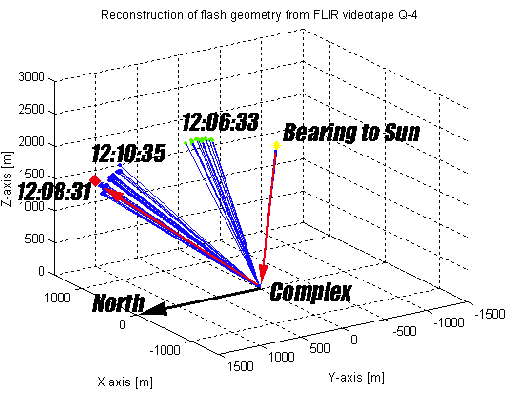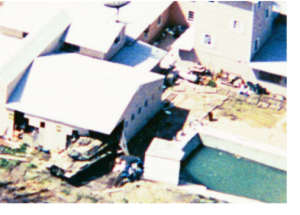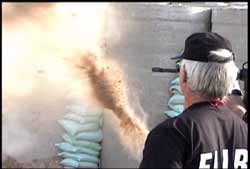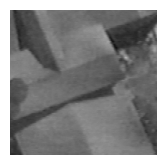
Debunking the Waco FLIR
(c) 2001 Ian Williams Goddard
The 51-day standoff in Waco, Texas between members of the Branch Davidian sect and federal agents ended tragically when the Mount Carmel Center burned to the ground, leaving over 70 inhabitants dead. Before and during the fire an aircraft circled overhead with a heat detecting FLIR (forward-looking infrared) video camera. The documentaries Waco: the Rules of Engagement [1] and Waco: A New Revelation [2] popularized the claim that the FLIR recorded gunshots being fired into Mt Carmel before and during the fire.
What is the evidence of gunfire on the Waco FLIR video? Bright flashes that appear on the ground and on the roof of Mt Carmel. However, when the Waco FLIR was run through the VIPER, a computer program that detects gunshots on FLIR, [3,4] no gunshots were found because the flashes are not like gunshots. [5] Additionally, expert analyses have shown that Waco flashes are thermal reflections on visible reflective debris. [6-8] These scientific analyses have not deterred proponents who continue to promote the claim that the flashes are gunfire.
The clip from the Waco FLIR on the left shows a flash that appears on the roof of Mt Carmel seen from an aircraft circling above. Consistent with the flash being a reflection of the hot sun, visible-light photos show a piece of glass in the same location as the flash. [9] Yet Waco FLIR gunshot proponents claim the flash is a gunshot. What do you think? |
FORENSIC REALITY vs MYTH
The cited Waco documentaries claim that flashes appearing on the Waco FLIR as the fire spreads are government agents shooting at Davidians as they tried to escape through the rear dining-room exit. The first documentary claims: "Most of the remaining Davidians were concentrated here in the kitchen dining room area, it was their only way out except for one thing, two men outside were firing machine guns at them." The documentary calls this alleged scenario "the machine-gunning of the Davidians trapped in the burning kitchen dining room." [1]
Waco: A New Revelation cites documentation allegedly confirming that many bodies were found near the dining-room exit. The documentary states that machine guns were "being fired into the back of the dining room" and that "according to the Justice Department report, at least fifteen people were found shot to death at this location." [2] Indeed, bullet-riddled bodies near the rear exit would seem to support that claim. However, consulting the cited source of documentation, the Justice Department report, reveals that in reality zero bodies are listed as being found in the dining room area. [10]
The following illustration is based on a map in the Treasury Department report that shows the locations of recovered bodies in Mt Carmel. [11] The location where the series of flashes appear during the fire is circled. Most shot bodies were found inside the concrete room shown below, which would shield those in it and in front of it from any gunshots coming from the flash location. The few shot bodies in a line of fire from the flash location were all shot in the head. [12] It's unlikely that a gunman firing blindly into a building would hit all his victims in the head. The easier explanation is that they were suicides or shot by others inside Mt Carmel.

The series of flashes that appear in the circled location above were caused by thermal reflections of the fire as it engulfed the floors above the concrete room. The flashes appear on a visible piece of debris attached to a fallen wall panel (the debris may be thermally reflective Mylar-film insulation). Gale-force winds cause the piece of debris to rapidly flap, which causes rapid flashing that produces an illusion of machine-gun fire. [13]
The absence of bodies near the rear exit debunks two key propositions of the gunshot claim: (1) that Davidians were machine-gunned as they tried to escape the fire through the rear exit and (2) that the official report says fifteen shot bodies were found near the rear exit.
PHYSICAL REALITY vs MYTH

The Justice Department's fire investigator James Quintiere opined that the Waco flashes are solar reflections on debris. [14] The Waco documentaries [1,2] countered Quintiere with the claim that FLIR cannot detect solar reflections. However, FLIR tests conducted by Vector Data [8] and Klasen and Madsen [6] proved that specular solar reflections can produce bright white flashes in the same region of the electromagnetic spectrum the Waco FLIR detects. Furthermore, the FLIR image on the left from Waco: A New Revelation [2] shows a helicopter during the US invasion of Somalia, which just happens to have a bright solar reflection on its windshield. [15]
All the Waco flashes are clear examples of solar reflections (except for some that are thermal reflections of the fire [13] and others that reflect a tank's hot exhaust panel [16] ). One example: the first two images below are from the Waco FLIR. The second shows a flash that appears in a window at 12:08:31 pm. [17] The third image, a visible-light photo, shows the same window close-up, which is at the end of the collapsed gym catwalk.

The Waco documentaries claim that this flash is an FBI bomb exploding inside Mt Carmel seen through a window. Yet the third image shows that the window was flat on the ground. The next graphic from the Klasen- Madsen report [6] shows that at 12:08:31 the aircraft (red box) was in the exact position necessary to intersect a beam of reflected solar energy (red arrow) coming from a specular solar reflection on the fallen window, which the moving FLIR sensor would record as a flash.

BALLISTIC REALITY vs MYTH
The Justice Department appointed John Danforth to examine the claims made in the Waco documentaries. [1,2] The Danforth retained Vector Data Systems to analyze the Waco FLIR and conduct tests in order to gather empirical data about solar reflections and gunshots on FLIR. Vector Data's results showed that gun-muzzle flashes appeared on FLIR video for no longer than 1 video frame (1/30 second). And just like the Waco flashes, solar reflections on debris produced bright flashes that appeared for multiple video frames recorded by a FLIR mounted on an aircraft circling overhead like the aircraft at Waco. [8]
All FLIR tests conducted by (a) Vector Data, (b) a lawyer for the Davidians, and (c) Waco: A New Revelation have confirmed what the scientific literature shows: the duration of gun-muzzle flashes will not exceed the duration of 1 video frame. These tests used a wide range of firearms, including low and high caliber automatic guns. The reason for the 1-frame limit is simple: the physical event of a muzzle flash lasts roughly 2 milliseconds -- 16.5 times shorter than 1 video frame. [18] Ergo: the problem for the Waco FLIR gunshot claim is that gunshots appear on FLIR for only 1 video frame, however, like solar reflections the Waco flashes appear for an average duration of 7 video frames. [19] For the same reason that the statement "7 = 1" is false, the statement "The Waco FLIR flashes (7) are like (=) gunshots (1)" is false.
|
To the naked eye, many of the Waco FLIR flashes look like what one would assume gunshots would look like. Viewers readily interpret this assumed similarity as prima facie, or obvious, evidence of gunfire. However, when the gunshot claim is subjected to the objective rules of the scientific method it fails for the same reason it fails when subjected to the mathematical rules in the algorithm of the VIPER gunshot-detection program [3-5] -- it fails because the Waco flashes are actually not like gun-muzzle flashes. That, plus the facts that the objects upon which flashes occur can be seen and no shooters are ever seen at or moving to or from the flash locations, is why the Justice Department's Office of Special Council concluded that the flashes recorded on the Waco FLIR are not gunshots.
ANOTHER CLAIM BITES THE DUST
Michael McNulty, producer of the Waco documentaries, [1,2] also produced, The FLIR Project, [22] which introduces a new scenario. While his tests confirmed that muzzle flashes have a natural duration no longer than 1 video frame, McNulty discovered that the thermal signature of a muzzle flash could be sustained for up to 5 video frames if the gun is fired into a thick cloud of dust. The flash duration was extended because dust particles lingering in a muzzle-flash zone were heated by the flash and dissipated their heat over 5 video frames, almost as long as the 7-frame average of Waco flashes.

However, just as the Waco flashes do not resemble real gunshots, clouds of stagnant dust do not resemble the environment around Mt Carmel where the flashes were recorded. The cloud of dust into which guns were fired in McNulty's test seen below was so thick it obscured visibility by 100%. Yet video and photos clearly show that the air around Mt Carmel was clear. The photo on the left shows the rear of Mt Carmel where many reflections on debris were recorded by the FLIR. As we can see, there are no dust clouds. Not even the tank penetrating the gym is kicking up dust.

McNulty's FLIR test, gun fired into dust cloud.
Even if there were clouds of dust around Mt Carmel the dust scenario fails. Heated particles of dust in McNulty's test lingered in one fixed location for 5 video frames because there was no wind. However, there were continuous winds of 28 to 46 mph blowing across Mt Carmel when the Waco flashes were recorded. [23] A dust particle traveling 30 mph will move 1.5 feet during the duration of 1 video frame (1/30 sec). [24] Therefore, a cloud of heated dust would have traveled 10.5 feet during the 7 video frames of the average Waco flash. However, all the Waco flashes stay in one fixed location (on debris) throughout their appearance. So the dust scenario fails even if clouds of dust were around Mt Carmel.
CONCLUSION
The Waco FLIR gunshot claim purports that federal agents machine gunned men, women, and children as they tried to escape the Waco fire. In other words, the United States government is guilty of the systematic mass murder of its own citizens -- a crime against humanity. However, as the facts above demonstrate, the alleged evidentiary basis for this most serious charge -- that the official report lists fifteen bodies shot to death near the rear exit -- is completely false. And the flashes recorded on FLIR that are said to be the gunshots killing those allegedly trying to escape do not actually resemble real gunshots. Instead, the long durations of the flashes resemble thermal reflections. Furthermore, the flashes appear on detectable pieces of reflective debris. The entire Waco FLIR gunshot/mass murder claim is a confabulated mirage built upon falsity and bad analysis.
Prior to the acquisition of empirical data about gun-muzzle flashes and thermal reflections on FLIR, prior to detailed analyses of the contents of the Waco FLIR, and based on naive immediate appearances it was a reasonable concern that the flashes might be gunshots directed at Mt Carmel. However, given the empirical data and analyses cited in this report there is little room for doubt that the Waco FLIR flashes are thermal reflections on debris, not gunshots.
comprehensive flash-by-flash analyses
[1] Waco: The Rules of Engagement. Fifth Estate Productions, 1996.
[2] Waco: A New Revelation. MGA Films, 1999.
[3] Gunfire Location and Incident Documentation System. Maryland Advanced Development Laboratory.
[4] Moroz, S.A., Gower, P.W., Pierson, R. Sniper Detection and Counterfire Direction. 1997 NRL Review. Naval Research Laboratory, Washington D.C., 1997, pages 91-92.
[5] Leiby, R. Report Says Flashes Not Gunfire. The Washington Post, June 20, 1997.
[6] Klasen, L., Madsen, S. Waco Investigation: Image Analysis and Video Authentication. FLIR Systems and Video, October 4, 2000.
[7] Klasen, L. Investigative Image Processing: The Waco Investigation. SSAB Symposium on Image Analysis, March 2001.
[8] Imagery Analysis Report, The Events at Waco Texas 19 April 1993. Vector Data Systems, May 5, 2000.
[9] Ibid., page 32.
[10] U.S. Department of Justice. Report to the Deputy Attorney General on the Events at Waco, Texas, February 28 to April 19, 1993. Washington, D.C., October 8, 1993, pages 313-28.
[11] Department of the Treasury. Report of the Department of the Treasury on the Bureau of Alcohol, Tobacco, and Firearms Investigation of Vernon Wayne Howell also known as David Koresh. U.S. Government Printing Office: Washington DC, September 1993, page 47. The map of body locations shows one body (#48) near the rear exit, which is not included in the illustration above because it is identified as a dog.
[12] Shot bodies in a line of fire from the location of the flashes that appear during the fire (circled in illustration above) were all shot in the head and were bodies (Doe) number 7, 8, 34, 35, 36, 39, and 41 (also see). Recommended: Dan Tucker's anlysis of the flashes during the fire and other claims in McNulty's Waco: A New Revelation.
[13] Goddard, I. The Waco FLIR Flashes, Flash Location 4. Goddard's Journal, June 5, 2000.
[14] Congressional Hearings, 1995.
[15] Credit for noticing the solar reflection on the helicopter goes to Dan Tucker, whose recommended analyses are cited in footnote 12.
[16] Goddard, I. The Waco FLIR Flashes, Flash Location 2. Goddard's Journal, July 13, 2000.
[17] Goddard, I. The Waco FLIR Flashes, Flash Location 3. Goddard's Journal, July 26, 2000.
[18] Klingenberg, G., Heimerl, J. Gun Muzzle Blast and Flash. Progress in Astronautics and Aeronautics, Volume 139, 1992, page 474.
[19] Vector Data Systems [8] flew a FLIR-mounted aircraft over reflective debris such as glass shards on the ground at Fort Hood to simulate the aircraft over Waco. About the durations of the resulting flashes the Ft Hood test report (page 23) says the flashes were "visible for varying times, but can be 0.40 seconds or longer." Waco flash durations also vary and can be 0.40 seconds (12 video frames) or longer. However, I wanted to know the average duration of Waco flashes. In frame-by-frame analysis I counted a total of 71 flashes -- all of which are claimed to be gunshots. The 71 flashes lasted a total of 504 video frames. So the average duration of the Waco flashes (504 divided by 71) equals 7 video frames. Real gun-muzzle flashes never exceed 1 video frame. Many of those flashes can be seen here.
[20] Vanderhoff, J., Kotlar, R., Peterson, R. CARS Temperature Measurements in the Muzzle Flash Region of a 7.62 mm Rifle. US Army Ballistic Research Laboratory, Maryland, November 1987, page 35.
[21] The stated cyclic rate of an M-16 is 700 to 950 rounds per minute, or 12 to 16 rounds per second. However, frame by frame analysis of an M-16 firing full automatic shown in Waco: A New Revelation finds an actual cyclic rate of only 6 rounds per second. With 30 video frames per second, the highest cyclic rate would leave one frame with no flash between each frame with a flash, and the actual measured rate of 6 rounds per second would leave 3 no-flash frames between each frame with a flash. In no case would an M-16 fire rounds fast enough to produce a multi-frame flash comparable to the average 7-frame duration of Waco flashes.
[22] The F.L.I.R. Project. A COPS Production, LLC Films, 2001.
[23] Sherrow, R. Fire Investigator's Civil Suit Affidavit On Origin of April 19, 1993 Fire at Mount Carmel. U.S. District Court for the Southern District of Texas Houston Division, January 17, 1996.
[24] A particle of dust traveling 30 mph would travel 1.5 feet during the duration of one VHS video frame (1/30 sec). Proof: 1 mile = 5280 feet, thus 30 mph = 5280 * 30 = 158,400 feet per hour. 158,400(fph)/60 = 2640 feet per minute. 2640(fpm)/60 = 44 feet per second. 44(fps)/30 = 1.5 feet per video frame. During the average 7-video-frame duration of the Waco flashes a dust particle traveling 30 mph would travel (7 * 1.5) 10.5 feet, yet the Waco flashes remain in fixed locations throughout their multi-frame durations despite continuous 28 to 46 mph winds. Ergo: the proposition that the multi-frame duration of Waco flashes is a consequence of muzzle-flash heated dust particles is illogical.
The Waco FLIR Flashes
my journal
my home page

